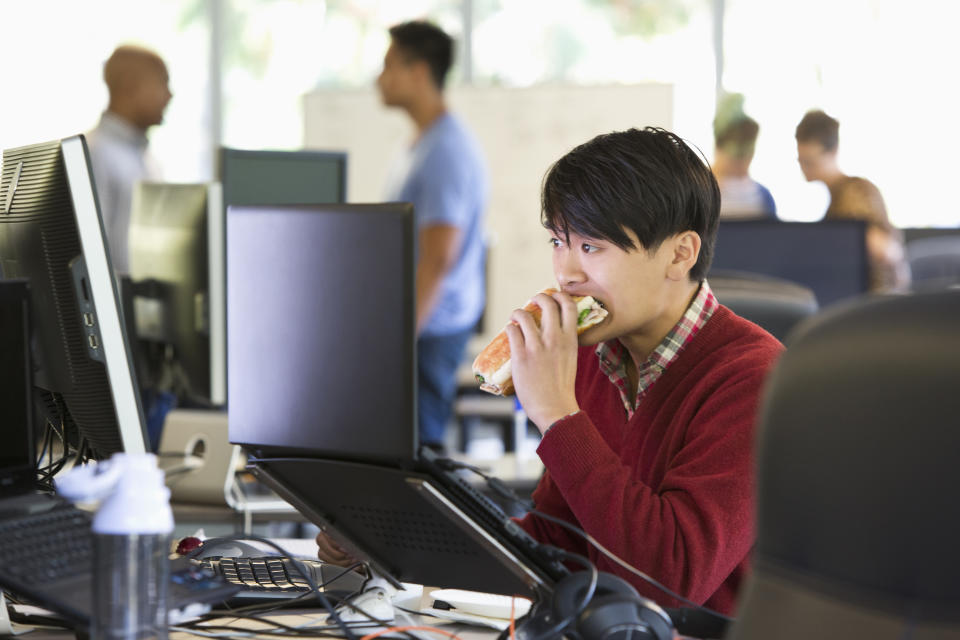Should we introduce rules for office desk dining?

Gone are the days of leaving the office to take a leisurely lunch.
For most of us, our “break” consists of shovelling in a sandwich and a coffee while continuing to hammer away at the keyboard, replying to emails and finishing other tasks.
Almost a quarter of us eat lunch at our desks, a survey by recruitment firm Glassdoor found, with one in four people admitting to eating “al desko” out of fear of falling behind at work.
“The lunch hour is becoming a thing of the past and fewer people have the time or inclination to take a long lunch break anymore,” said John Lamphiere, EMEA Managing Director at Glassdoor.
With so many of us eating in open plan offices, you would hope most desk lunches would be fairly innocuous, like a Pret baguette or a supermarket salad. Sometimes, though, you find yourself next to a colleague who has brought in last night’s dinner.
And even worse, they’ve chosen to reheat it in the communal microwave, filling the air with an aroma of fish and broccoli.
The smell is inescapable and begs the question, should we introduce stricter rules when it comes to eating at work?
The rules of ‘Al desko’ dining
Introducing official guidelines to what can and can’t be consumed in an office may be a step too far for employers, particularly when so many workers have heavy workloads and are forced to eat at their desks. However, there are some general rules that most people agree should be followed.
Firstly, there are certain foods that cause more irritation than others. Anything with a strong aroma should be avoided, but even foods like crisps, biscuits or an apple can be annoying to some who can’t stand hearing the chewing and crunching in a quiet office.
A quick question on Twitter reveals some of the most offensive foods co-workers have brought in.
“Fish for breakfast,” one person wrote. “Salmon,” another adds. And finally, perhaps the worst offender: “Egg salad in a meeting.”
If your work schedule leaves little time to head out for food, it’s best to eat at your desk during the typical lunch hour. If everyone around you is eating, you’re less likely to annoy people or distract your colleagues.
READ MORE: Can you train yourself to be a morning person?
There are also certain circumstances when staff probably shouldn’t eat, too. Unless there are no other options and it is given the all clear by the bosses, eating in a meeting is generally a no-no.
And when it comes to reheating food in the microwave, just beware that the smell of hot food travels further and lingers far longer than a simple sandwich. If you really do have to eat your leftover stew at work, try to limit the odour to the kitchen or a quiet - and empty - area of the office.
Aside from irritating other co-workers, there are other risks associated with eating at your desk. Although many people think that working through their lunch breaks will help their get ahead in their careers, this isn’t true. Rather, taking regular breaks is one of the best ways to boost productivity and refresh cognitive function, making us far more likely to get more done and do it well.
Last year, a survey by the hygiene products company Tork found 90% of US employees believe taking a lunch break helps them feel refreshed and ready to get back to work. A proper lunch break can also reduce stress, a problem which can lead to burnout - a state of chronic stress that impacts both mental and physical health.
READ MORE: How to negotiate flexible working at work
For those who feel uncomfortable leaving their offices for lunch, it’s important they have somewhere to eat that isn’t just their desks. More than half of UK office workers do not have a dedicated space to eat lunch in the workplace, according to a 2018 survey by the company Furniture123.
“Happy workers are more productive. This sentiment has been proven time and time again, and it’s one of the many reasons why it’s so important to keep employees on side,” said Mark Kelly, marketing manager who led the research.
“Providing staff with somewhere to eat lunch is an office essential, and the simple act of getting away from the desk and taking a break, even for ten minutes, enables workers to push the reset button and come back to work with a clearer head and renewed focus.”

 Yahoo Finance
Yahoo Finance 